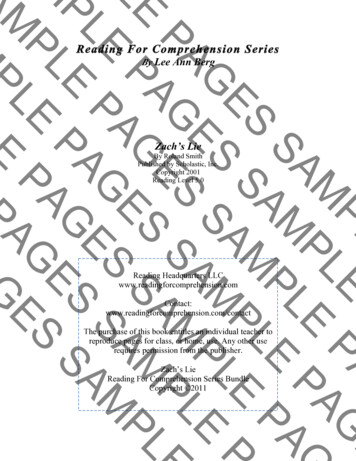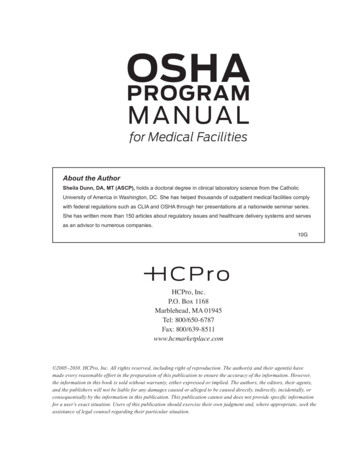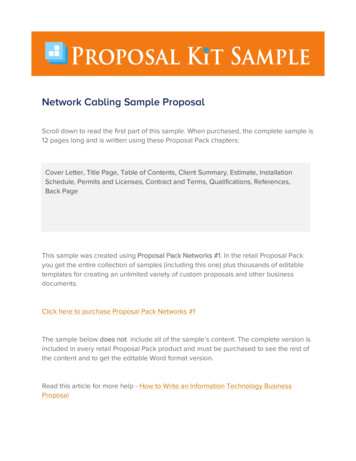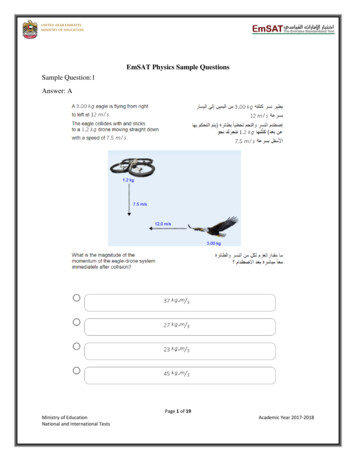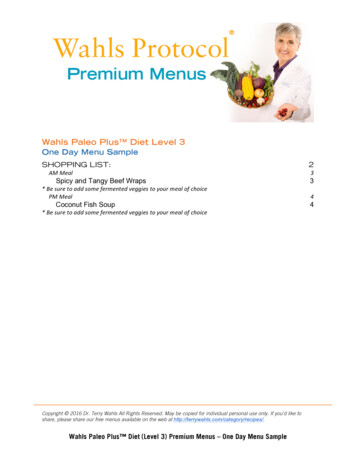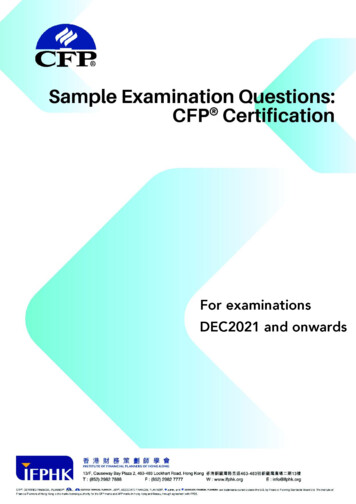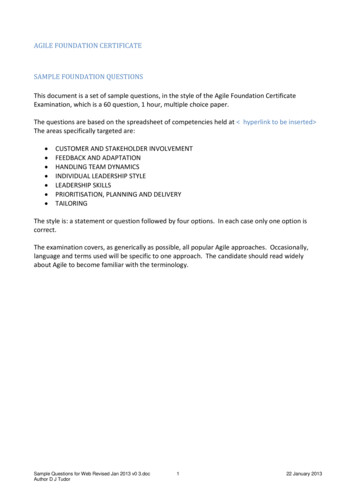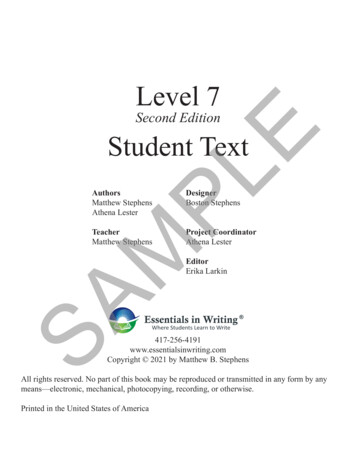
Transcription
Level 7PLESecond EditionStudent TextDesignerBoston StephensTeacherMatthew StephensProject CoordinatorAthena LesterSAMAuthorsMatthew StephensAthena LesterEditorErika ight 2021 by Matthew B. StephensAll rights reserved. No part of this book may be reproduced or transmitted in any form by anymeans—electronic, mechanical, photocopying, recording, or otherwise.Printed in the United States of America
TABLE OF CONTENTSUNIT ONE: GRAMMARLesson 1: Introduction to Writing.2TOOLS FOR EFFECTIVE COMMUNICATIONPLEApply Parts of SpeechLesson 2: Adjectives in Action. 5Lesson 3: Action Verbs in Action. 15Lesson 4: Adverbs in Action.26Lesson 5: Prepositional Phrases in Action.33Lesson 6: Gerunds in Action.40Lesson 7: Vivid Language.43SAMApply Sentence StructureLesson 8: Independent and Dependent Clauses.53Lesson 9: Simple and Compound Sentences.58Lesson 10: Compound Sentences and Avoiding Sentence Errors .64Lesson 11: Complex Sentences.70Lesson 12: Complex Sentences and Avoiding Sentence Errors.76Lesson 13: Varied Sentences in a Composition.80Lesson 14: Using Appositives.89Lesson 15: Using Transitions.93Common ProblemsLesson 16: Pronouns and Antecedents.101Lesson 17: Subject/Verb Agreement.106Lesson 18: Don’t/Doesn’t Problem.110Lesson 19: Homophones.114Lesson 20: Unclear Subject Problem.119Lesson 21: Paraphrasing.124Lesson 22: Writing a Summary.128UNIT TWO: COMPOSITIONLesson 23: The Writing Process.134ParagraphsLesson 24: Paragraph Overview – Opening Sentence, Body, Closing Sentence.136Lesson 25: Expository Paragraph – Brainstorm.139Lesson 26: Expository Paragraph – Organize, Draft.140Lesson 27: Expository Paragraph – Revise, Final Draft.142
PLELesson 28: Persuasive Paragraph – Brainstorm.147Lesson 29: Persuasive Paragraph – Organize, Draft.148Lesson 30: Persuasive Paragraph – Revise, Final Draft.150Lesson 31: Descriptive Paragraph – Brainstorm.155Lesson 32: Descriptive Paragraph – Organize, Draft.156Lesson 33: Descriptive Paragraph – Revise, Final Draft.158Lesson 34: Compare Paragraph – Brainstorm.163Lesson 35: Compare Paragraph – Organize, Draft.164Lesson 36: Compare Paragraph – Revise, Final Draft.166Lesson 37: Contrast Paragraph – Brainstorm, Organize, Draft.171Lesson 38: Contrast Paragraph – Revise, Final Draft.174SAMPersonal NarrativeLesson 39: Personal Narrative.179Lesson 40: Mechanics of Dialogue.180Lesson 41: Brainstorm.185Lesson 42: Organize.186Lesson 43: Hook and Draft.188Lesson 44: Revise Word Choice.189Lesson 45: Revise Sentence Structure.190Lesson 46: Add Dialogue.191Lesson 47: Final Draft.192Persuasive Business LetterLesson 48: Persuasive Business Letter – Audience, Purpose, and Format.196Lesson 49: Brainstorm.198Lesson 50: Organize.199Lesson 51: Organize and Draft Opening Paragraph.201Lesson 52: Draft Body Paragraphs.202Lesson 53: Organize and Draft Closing Paragraph.203Lesson 54: Revise Word Choice.204Lesson 55: Revise Sentence Structure.205Lesson 56: Final Draft.206Expository EssayLesson 57: Expository Essay.211Lesson 58: Brainstorm and Organize.212Lesson 59: Organize and Draft Body Paragraph #1.214Lesson 60: Organize and Draft Body Paragraph #2.216Lesson 61: Organize and Draft Body Paragraph #3.218
Lesson 62: Organize and Draft Opening Paragraph.220Lesson 63: Organize and Draft Closing Paragraph.221Lesson 64: Revise Word Choice.222Lesson 65: Revise Sentence Structure.223Lesson 66: Final Draft .224PLEDescriptive Personal LetterLesson 67: Descriptive Personal Letter.228Lesson 68: Brainstorm.230Lesson 69: Organize and Draft Opening Paragraph.232Lesson 70: Organize Body Paragraph.233Lesson 71: Draft Body Paragraph.234Lesson 72: Organize and Draft Closing Paragraph.235Lesson 73: Revise Word Choice.236Lesson 74: Revise Sentence Structure.237Lesson 75: Final Draft.238SAMResearch ProjectLesson 76: Process.242Lesson 77: Brainstorm.243Lesson 78: Research Questions.244Lesson 79: Quality Sources.245Lesson 80: Source Cards.247Lesson 81: Notecards.248Lesson 82: Research.249Lesson 83: Organize Notecards and Thesis Statement.250Lesson 84: Draft Body Paragraphs.251Lesson 85: Organize and Draft Opening Paragraph.252Lesson 86: Organize and Draft Closing Paragraph.253Lesson 87: Revise Word Choice.254Lesson 88: Revise Sentence Structure.255Lesson 89: Final Draft (Presentation Board or Written Report).256Lesson 90: Bibliography.259Final Lesson – Comparing Compositions.263SOURCE CARDS
LEVEL 7 SYLLABUSSecond EditionVIDEO – 91 LESSONSWORKBOOK – 263 PAGESNOTE: Video lessons are indicated by ALL CAPS bold. Worksheets/assignment sheets are listed below each video lesson.LESSON 1: INTRODUCTION TO WRITINGLesson 1 Day 1 – Introduction to WritingLESSON 9: SIMPLE AND COMPOUNDSENTENCESLesson 9 Day 1 – Simple and Compound SentencesLesson 9 Day 2 – Simple and Compound SentencesLesson 9 Day 3 – Simple and Compound SentencesLESSON 2: ADJECTIVES IN ACTIONLesson 2 Day 1 – Adjectives in ActionLesson 2 Day 2 – Adjectives in ActionLesson 2 Day 3 – Adjectives in ActionLesson 2 Day 4 – Adjectives in Action*Assessment 1 (Lesson 2)PLELESSON 10: COMPOUND SENTENCES ANDAVOIDING SENTENCE ERRORSLesson 10 Day 1 – FragmentsLesson 10 Day 2 – Run-OnsLesson 10 Day 3 – Comma Splices*Assessment 7 (Lessons 8-10)LESSON 3: ACTION VERBS IN ACTIONLesson 3 Day 1 – Action Verbs in ActionLesson 3 Day 2 – Action Verbs in ActionLesson 3 Day 3 – Action Verbs in ActionLesson 3 Day 4 – Action Verbs in Action*Assessment 2 (Lesson 3)LESSON 11: COMPLEX SENTENCESLesson 11 Day 1 – Complex SentencesLesson 11 Day 2 – Complex SentencesLesson 11 Day 3 – Complex SentencesLESSON 4: ADVERBS IN ACTIONLesson 4 Day 1 – Adverbs in ActionLesson 4 Day 2 – Adverbs in ActionLesson 4 Day 3 – Adverbs in Action*Assessment 3 (Lesson 4)LESSON 12: COMPLEX SENTENCES ANDAVOIDING SENTENCE ERRORSLesson 12 Day 1 – FragmentsLesson 12 Day 2 – Run-Ons*Assessment 8 (Lessons 11-12)SAMLESSON 5: PREPOSITIONAL PHRASES INACTIONLesson 5 Day 1 – Prepositional Phrases in ActionLesson 5 Day 2 – Prepositional Phrases in ActionLesson 5 Day 3 – Prepositional Phrases in Action*Assessment 4 (Lesson 5)LESSON 13: VARIED SENTENCES IN ACOMPOSITIONLesson 13 Day 1 – Varied Sentences in a CompositionLesson 13 Day 2 – Varied Sentences in a CompositionLesson 13 Day 3 – Varied Sentences in a CompositionLesson 13 Day 4 – Varied Sentences in a CompositionLesson 13 Day 5 – Varied Sentences in a CompositionLesson 13 Day 6 – Varied Sentences in a CompositionLesson 13 Day 7 – Varied Sentences in a CompositionLESSON 6: GERUNDS IN ACTIONLesson 6 Day 1 – Gerunds in ActionLesson 6 Day 2 – Gerunds in Action*Assessment 5 (Lesson 6)LESSON 14: USING APPOSITIVESLesson 14 Day 1 – Using AppositivesLesson 14 Day 2 – Using Appositives*Assessment 9 (Lesson 14)LESSON 7: VIVID LANGUAGELesson 7 Day 1 – Vivid LanguageLesson 7 Day 2 – Vivid LanguageLesson 7 Day 3 – Vivid LanguageLesson 7 Day 4 – Vivid Language*Assessment 6 (Lesson 7)LESSON 15: USING TRANSITIONSLesson 15 Day 1 – Using TransitionsLesson 15 Day 2 – Using TransitionsLesson 15 Day 3 – Using Transitions*Assessment 10 (Lesson 15)LESSON 8: INDEPENDENT AND DEPENDENTCLAUSESLesson 8 Day 1 – Independent and Dependent ClausesLesson 8 Day 2 – Independent and Dependent ClausesLESSON 16: PRONOUNS AND ANTECEDENTSLesson 16 Day 1 – Pronouns and AntecedentsLesson 16 Day 2 – Pronouns and AntecedentsLesson 16 Day 3 – Pronouns and Antecedents*Assessment 11 (Lesson 16)6
LESSON 17: SUBJECT/VERB AGREEMENTLesson 17 Day 1 – Subject/Verb AgreementLesson 17 Day 2 – Subject/Verb AgreementLesson 17 Day 3 – Subject/Verb AgreementLESSON 29: PERSUASIVE PARAGRAPHLesson 29 Day 1 – OrganizeLesson 29 Day 1 – DraftLESSON 30: PERSUASIVE PARAGRAPHLesson 30 Day 1 – ReviseLesson 30 Day 1 – Final DraftPersuasive Paragraph – Extra PracticeLESSON 18: DON’T/DOESN’T PROBLEMLesson 18 Day 1 – Don’t/Doesn’t ProblemLesson 18 Day 2 – Don’t/Doesn’t ProblemLesson 18 Day 3 – Don’t/Doesn’t Problem*Assessment 12 (Lessons 17-18)LESSON 32: DESCRIPTIVE PARAGRAPHLesson 32 Day 1 – OrganizeLesson 32 Day 2 – DraftPLELESSON 19: HOMOPHONESLesson 19 Day 1 – HomophonesLesson 19 Day 2 – HomophonesLesson 19 Day 3 – Homophones*Assessment 13 (Lesson 19)LESSON 31: DESCRIPTIVE PARAGRAPHLesson 31 Day 1 – BrainstormLESSON 33: DESCRIPTIVE PARAGRAPHLesson 33 Day 1 – ReviseLesson 33 Day 1 – Final DraftDescriptive Paragraph – Extra PracticeLESSON 20: UNCLEAR SUBJECT PROBLEMLesson 20 Day 1 – Unclear Subject ProblemLesson 20 Day 2 – Unclear Subject ProblemLesson 20 Day 3 – Unclear Subject Problem*Assessment 14 (Lesson 20)LESSON 21: PARAPHRASINGLesson 21 Day 1 – ParaphrasingLesson 21 Day 2 – ParaphrasingLESSON 34: COMPARE PARAGRAPHLesson 34 Day 1 – BrainstormLESSON 35: COMPARE PARAGRAPHLesson 35 Day 1 – OrganizeLesson 35 Day 1 – DraftSAMLESSON 22: WRITING A SUMMARYLesson 22 Day 1 – Writing a SummaryLesson 22 Day 2 – Writing a Summary*Assessment 15 (Lessons 21-22)*UNIT ONE COMPREHENSIVE ASSESSMENT(Lessons 2-22)LESSON 23: THE WRITING PROCESSLesson 23 Day 1 – The Writing ProcessLESSON 24: PARAGRAPH OVERVIEWLesson 24 Day 1 – Opening SentenceLesson 24 Day 1 – BodyLesson 24 Day 1 – Closing SentenceLESSON 25: EXPOSITORY PARAGRAPHLesson 25 Day 1 – BrainstormLESSON 26: EXPOSITORY PARAGRAPHLesson 26 Day 1 – OrganizeLesson 26 Day 1 - DraftLESSON 27: EXPOSITORY PARAGRAPHLesson 27 Day 1 – ReviseLesson 27 Day 1 – Final DraftExpository Paragraph – Extra PracticeLESSON 36: COMPARE PARAGRAPHLesson 36 Day 1 – ReviseLesson 36 Day 1 – Final DraftCompare Paragraph – Extra PracticeLESSON 37: CONTRAST PARAGRAPHLesson 37 Day 1 – BrainstormLesson 37 Day 1 – OrganizeLesson 37 Day 1 – DraftLESSON 38: CONTRAST PARAGRAPHLesson 38 Day 1 – ReviseLesson 38 Day 1 – Final DraftContrast Paragraph – Extra Practice*Assessment 16 (Lessons 23-38)LESSON 39: PERSONAL NARRATIVELesson 39 Day 1 – Personal NarrativeLESSON 40: PERSONAL NARRATIVELesson 40 Day 1 – Mechanics of DialogueLesson 40 Day 2 – Mechanics of DialogueLesson 40 Day 3 – Mechanics of DialogueLESSON 41: PERSONAL NARRATIVELesson 41 Day 1 – BrainstormLESSON 28: PERSUASIVE PARAGRAPHLesson 28 Day 1 – BrainstormLESSON 42: PERSONAL NARRATIVELesson 42 Day 1 – Organize7
LESSON 61: EXPOSITORY ESSAYLesson 61 Day 1 – Organize and Draft Body Paragraph #3LESSON 44: PERSONAL NARRATIVELesson 44 Day 1 – Revise Word ChoiceLESSON 62: EXPOSITORY ESSAYLesson 62 Day 1 – Organize and Draft Opening ParagraphLESSON 45: PERSONAL NARRATIVELesson 45 Day 1 – Revise Sentence StructureLESSON 63: EXPOSITORY ESSAYLesson 63 Day 1 – Organize and Draft Closing ParagraphLESSON 46: PERSONAL NARRATIVELesson 46 Day 1 – Add DialogueLESSON 64: EXPOSITORY ESSAYLesson 64 Day 1 – Revise Word ChoiceLESSON 47: PERSONAL NARRATIVELesson 47 Day 1 – Final DraftPersonal Narrative – Extra Practice*Assessment 17 (Lessons 39-47)LESSON 65: EXPOSITORY ESSAYLesson 65 Day 1 – Revise Sentence StructurePLELESSON 43: PERSONAL NARRATIVELesson 43 Day 1 – Hook and DraftLESSON 49: PERSUASIVE BUSINESS LETTERLesson 49 Day 1 – BrainstormLESSON 67: DESCRIPTIVE PERSONAL LETTERLesson 67 Day 1 – Descriptive Personal LetterLESSON 50: PERSUASIVE BUSINESS LETTERLesson 50 Day 1 – OrganizeLESSON 68: DESCRIPTIVE PERSONAL LETTERLesson 68 Day 1 – BrainstormLESSON 51: PERSUASIVE BUSINESS LETTERLesson 51 Day 1 – Organize and Draft Opening ParagraphLESSON 69: DESCRIPTIVE PERSONAL LETTERLesson 69 Day 1 – Organize and Draft Opening ParagraphLESSON 52: PERSUASIVE BUSINESS LETTERLesson 52 Day 1 – Draft Body ParagraphsLESSON 70: DESCRIPTIVE PERSONAL LETTERLesson 70 Day 1 – Organize Body ParagraphSAMLESSON 48: PERSUASIVE BUSINESS LETTERLesson 48 Day 1 – Audience, Purpose, and FormatLESSON 66: EXPOSITORY ESSAYLesson 66 Day 1 – Final DraftExpository Essay – Extra Practice*Assessment 19 (Lessons 57-66)LESSON 53: PERSUASIVE BUSINESS LETTERLesson 53 Day 1 – Organize and Draft Closing ParagraphLESSON 71: DESCRIPTIVE PERSONAL LETTERLesson 71 Day 1 – Draft Body ParagraphLESSON 54: PERSUASIVE BUSINESS LETTERLesson 54 Day 1 – Revise Word ChoiceLESSON 72: DESCRIPTIVE PERSONAL LETTERLesson 72 Day 1 – Organize and Draft Closing ParagraphLESSON 55: PERSUASIVE BUSINESS LETTERLesson 55 Day 1 – Revise Sentence StructureLESSON 73: DESCRIPTIVE PERSONAL LETTERLesson 73 Day 1 – Revise Word ChoiceLESSON 56: PERSUASIVE BUSINESS LETTERLesson 56 Day 1 – Final DraftPersuasive Business Letter – Extra Practice*Assessment 18 (Lessons 48-56)LESSON 74: DESCRIPTIVE PERSONAL LETTERLesson 74 Day 1 – Revise Sentence StructureLESSON 57: EXPOSITORY ESSAYLesson 57 Day 1 – Expository EssayLESSON 75: DESCRIPTIVE PERSONAL LETTERLesson 75 Day 1 – Final DraftDescriptive Personal Letter – Extra Practice*Assessment 20 (Lessons 67-75)LESSON 58: EXPOSITORY ESSAYLesson 58 Day 1 – Brainstorm and OrganizeLESSON 76: RESEARCH PROJECTLesson 76 Day 1 – ProcessLESSON 59: EXPOSITORY ESSAYLesson 59 Day 1 – Organize and Draft Body Paragraph #1LESSON 77: RESEARCH PROJECTLesson 77 Day 1 – BrainstormLESSON 60: EXPOSITORY ESSAYLesson 60 Day 1 – Organize and Draft Body Paragraph #2LESSON 78: RESEARCH PROJECTLesson 78 Day 1 – Research Questions8
LESSON 79: RESEARCH PROJECTLesson 79 Day 1 – Quality SourcesLESSON 80: RESEARCH PROJECTLesson 80 Day 1 – Source CardsLESSON 81: RESEARCH PROJECTLesson 81 Day 1 – NotecardsLESSON 82: RESEARCH PROJECTLesson 82 Days 1 – ResearchPLELESSON 83: RESEARCH PROJECTLesson 83 Day 1 – Organize Notecards and ThesisStatementLESSON 84: RESEARCH PROJECTLesson 84 Days 1 – Draft Body ParagraphsLESSON 85: RESEARCH PROJECTLesson 85 Day 1 – Organize and Draft Opening ParagraphLESSON 86: RESEARCH PROJECTLesson 86 Day 1 – Organize and Draft Closing ParagraphLESSON 87: RESEARCH PROJECTLesson 87 Day 1 – Revise Word ChoiceLESSON 88: RESEARCH PROJECTLesson 88 Day 1 – Revise Sentence StructureSAMLESSON 89: RESEARCH PROJECTLesson 89 Day 1 – Final Draft (Presentation Board orWritten Report)LESSON 90: RESEARCH PROJECTLesson 90 Day 1 – Bibliography*UNIT TWO COMPREHENSIVE ASSESSMENT(Lessons 23-75)FINAL LESSONComparing Compositions9
CONTENTUnit One: Grammar and Other TopicsAll lessons within this unit teach students how to apply parts of speech and sentence structure aswell as how to address common problems.PLEI. Tools for Effective CommunicationA. Apply Parts of SpeechB. Apply Sentence StructureC. Common ProblemsUnit Two: CompositionIn this unit, students explore many different types of compositions, focusing on the parts ofcompositions, the writing process, and applying effective writing tools.Students write with Mr. Stephens in a step-by-step/modeled approach to composition. During thevideo lessons, Mr. Stephens teaches students information and techniques and models how toperform each step of the writing process for individual compositions. Students apply what theylearn from the video lesson and information presented in the textbook.SAMStep-by-Step/Model: Through a step-by-step, repetitive process, students internalize the writingprocess and learn how to perform each step. Additionally, Mr. Stephens models the steps of eachcomposition, showing students “how” to complete them.Immediate Application: By focusing on each step of the writing process through short, modeledlessons with immediate application, students apply what they learn immediately withoutbecoming overwhelmed by other steps and/or forgetting previous steps. This method increasesretention.ASSESSMENTSA separate Assessment/Resource Booklet is available for purchase. The booklet contains: 20 assessments 2 comprehensive unit assessments graphic resource word lists, composition resources, and research resources additional organizers and research source cardsAssessments provide students opportunities to practice and put to test what they have learned inthe lessons if the parent/teacher believes the student will benefit from it. However, taking theassessments is not required. Students may reference their workbook at all times. In Unit 2, ifstudents need more experience with a type of composition, it is recommended that the studenteither works through the Extra Practice page in the workbook or completes the correspondingassessment and composition opportunity in the Assessment/Resource Booklet.2
ACTIVITIES AND ICONSIn Unit One, students learn to identify and apply parts of speech and sentence structure.Identify activities help students learn to identify parts of speech and sentence structure inwritten language.Apply activities help students identify and apply parts of speech and sentence structure whichare tools for effective communication through written language. This provides students withtools they will use when writing in Unit Two.PLEProgression of identify and apply activities within each practice session:1. Students identify and apply concepts in sentences and fill-in-the-blank activities.2. Students identify and apply what they have learned in written compositions activities.3. Students apply what they have learned in short original written compositions.Common Problems – In Unit One, the common problems icon will be present in activitiesthat focus on topics with which students frequently struggle, both Parts of Speech andSentence Structure topics.Grammar Section Toolbox – In Unit One, the toolbox will be present on all “apply”activities. The toolbox serves as a reminder to students that the skills practiced on the page aretools to help them communicate effectively in writing. In Unit Two, the toolbox remindsstudents when revising compositions to use their writing “tools” to improve communication.SAMThe Writing Process – The icons remind students which step of the writing process they Transitions – In Unit Two, the transitions icon will remind students to add or evaluate the useof transition words or phrases in their compositions to improve their communication.Extra Practice – After all steps of each composition have been complete and parents or teachers havecompleted the checklist, students have the opportunity to practice writing another composition of thesame type. They read the prompt on the “Extra Practice” page, and, just as before, watch each videolesson before completing each step of the writing process for the new composition. When organizingthoughts, students may draw graphic organizers on notebook paper or use the additional organizersprovided in the Assessment/Resource Booklet. If extra practice is needed, it is recommended that thestudent either works through the Extra Practice page in the workbook or completes the correspondingassessment and composition opportunity in the Assessment/Resource Booklet.Resource Folder – In Lessons 2, 3, 7, and 15, students are asked to begin creating a“Discarded Word List” and a “Transition Words and Phrases Word List” and place them in aresource folder. In Unit 2, students are asked to reference or to update the word lists after eachcomposition. This serves to build a resource file that is helpful for effective communication inthe coming lessons and years.3
SCORING ACTIVITIESHomeschool parents/teachers are free to use their own scoring system, but if you prefer, you are welcome touse the point values we assign to each activity. Total available points for each page of activities can be foundbeside each set of instructions on the activity pages. In general, Identify activities are worth 1 point each, andApply activities are worth 2 points each. Any activities that are to be scored only on a Completion grade willbe noted. If parents/teachers wish to assign point values to Completion grades, we recommend assigning 5points per Completion grade.SCORING COMPOSITIONSScoring Services are availablefor purchase for levels 7-12.Running from August 1 to May15 each school year, a certifiedmember of our Essentials inWriting team will score writtencompositions for any or allassignments presented in eachlevel purchased. Visit ourwebsite for more information.PLEScoring written compositions can be challenging due to theirsubjective nature. Ultimately, we encourage you to do what worksfor you, your student, and/or your schooling situation. If youalready use a method to score written compositions, stick with it.Along the way, try new methods.We provide Scoring Rubrics for each composition if you wish touse those to evaluate your student’s work. These rubrics displayour recommended balance and available point values. To use theserubrics, evaluate the compositions according to each category andcriteria, determine point values for each category, and then add upall awarded points for a final score.SAMWe also provide checklists for each composition that can be used either by the student as they finishcompositions or by the parent as they evaluate compositions. If you use the checklists to evaluatecompositions, focus primarily on completion and conversation. Use the checklist as a guide to discuss howeffective or ineffective a composition is as a whole and strengths and weaknesses evident in the composition.There are several different ways to utilize the rubrics and checklists and to hold discussions:1. Student completes the checklist before turning in the assignment, and the teacher uses the suggestedScoring Rubric to calculate a grade. The teacher spot-checks a few items and asks the student to point todifferent items on the checklist evident in the composition and explain why the item was checked. Then, theteacher fills out the Scoring Rubric.Teacher: “I see you marked that your narrative contains transitions. Show me your transitions.”Student points to the transitions, and Teacher assigns points to the appropriate category of the Scoring Rubric.2. Teacher checks each item on the checklist and assigns a grade. This works well when time is limited.Assign a letter grade based on the overall composition using the sample composition provided in the answerkey as a guide. Discuss one or more areas that may or may not include suggestions or requested revision.After completing the checklist, the teacher might say and ask something like:“I noticed that your hook for your opening par
Lesson 64 Day 1 – Revise Word Choice LESSON 65: EXPOSITORY ESSAY Lesson 65 Day 1 – Revise Sentence Structure LESSON 66: EXPOSITORY ESSAY Lesson 66 Day 1 – Final Draft Expository Essay – Extra Practice *Assessment 19 (Lessons 57-66) LESSON 67: DESCRIPTIVE PERSONAL LETTER Lesso




